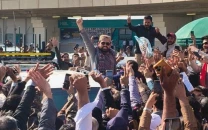Needed: A peace strategist
India, Pakistan, and the Kashmiris need to take incremental steps forward in terms of conflict resolution.

To kick-start the process, a symbolic gesture on Kashmir looked like a good idea. Indeed, it had to be without prejudice to the declared positions of India and Pakistan, preferably give hope that a resolution was seriously sought and sufficiently engage the people of the area to let the two countries get on with their less intractable issues. Ultimately, it was decided to start a bus service between the two parts of Kashmir. There was a risk: if an odd bus was blown up by any of the many detractors of the détente, at that nascent stage the process could have suffered a serious setback. Mercifully, that did not happen; nor did much else after the initial euphoria over the bus and some high profile visits by the Kashmiri leaders. The symbolism was still helpful. Pakistan needed respite on its eastern front since it was deep in trouble on all the others and India would use the lull to consolidate gains in the Valley.
The November 2008 mayhem in Mumbai provided the pretext to formally suspend a process that was not going anywhere. It will resume in due course. In the interregnum we should reflect a little.
The possibility that the “non-state actors” would try to derail the peace process was never in doubt. To deny them this handle, the two countries had earlier agreed to establish a Joint Anti-Terror Mechanism (JATM) to share intelligence and carry out joint investigation. It was not put in place. Consequently, the Mumbai dossier became the most travelled document in history. Ironically, some retired bureaucrats from both sides lobbied and blocked the mechanism — before it ever got a chance.
The bureaucracy cautions and the political leadership decides. Lately, the latter has done not too badly, but at times even the ‘political will’ could be seriously challenged. Movement in a dialogue depends upon what the players are prepared to concede. Inevitably one or the other side would be charged with “surrender” by its domestic opposition and public opinion. Derailing of the process would then be state-sponsored, and the resumption, in this case, would only be possible when the ground situation changes — for the worse.
Does that mean that India and Pakistan, even with the best of plans and intensions, were fated to remain at loggerheads? Possible, even likely; since both the countries believe they do not have to pay the price of compromise — India, understandably; and Pakistan too can live with the status quo. However, just in case they were forced to make peace, because either the cost of conflict became excessive or under internal pressure, the two would be better served by some good advice on conflict resolution. If war, easier to make than peace, seeks help from history, when making peace the need to be guided by experience was more acute.
Instead of reviling the JATM, an expert peacemaker would treat it as a ‘confidence building measure’. And when Musharraf was calling India almost on daily basis to move forward in Kashmir — zoning, joint control, demilitarisation, et al — someone could have explained to him why India was not responding. Media initiatives, unless already sounded out, embarrass the other camp and arouse suspicion. A fundamental principle of conflict resolution therefore is to take incremental steps with which all parties — in this case India, Pakistan, and the Kashmiris — can keep pace.
In view of India’s compulsion to suspend talks after Mumbai, a bit of innovation was needed to keep the process moving. One did hear some voices suggesting that the two countries could consider cooperation on better management of water resources and in Afghanistan. The indirect approach is often the better strategy.
And who knows a good “peace strategist” might even find a way to increase the cost of conflict to persuade a belligerent to make peace!
Published in The Express Tribune, November 20th, 2010.



















COMMENTS
Comments are moderated and generally will be posted if they are on-topic and not abusive.
For more information, please see our Comments FAQ